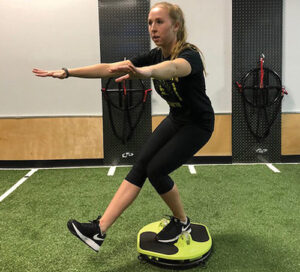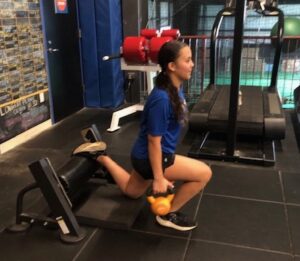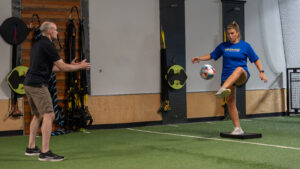Tips for Keeping Your Knees Strong and Healthy!
Introduction
Knee injuries are among the most common musculoskeletal issues seen in physical therapy clinics. Whether you’re an athlete, a weekend warrior, or simply enjoy staying active, the knee is particularly vulnerable to strain and injury due to its central role in supporting body weight and enabling movement. While treatment after injury is essential, prevention is even more powerful—and often overlooked. This is where a targeted preventative exercise program becomes a game-changer.
Why Are Knees So Vulnerable?
The knee joint is a complex hinge that bears the brunt of most physical activity, especially movements that involve running, jumping, pivoting, or heavy lifting. It’s stabilized by a network of ligaments (ACL, PCL, MCL, and LCL), tendons, and muscles, all of which need to function in harmony. When there’s weakness, imbalance, or poor biomechanics, the risk of injury—particularly ACL tears, meniscus damage, and patellofemoral pain syndrome—rises sharply.
Prevalence/Incidence
- Injuries occur frequently among these young athletes, with knee injuries accounting for 10–25% of all sports-related injuries
- Athletes involved in jumping, pivoting, or cutting, such as skiers or soccer players, are at increased risk for serious knee injuries including anterior cruciate ligament (ACL) tears
- An estimated 250,000 ACL-related injuries occur annually in the United States [4], leading to 80,000 to 100,000 surgical ACL reconstruction surgeries per year
- Female athletes are 2 to 8 times more likely to injure their ACL compared to their male counterparts
- ACL injury prevention programs reduce incidence of ACL injuries by at least 50%
The Role of Preventative Exercise
Preventative exercise programs are designed to strengthen key muscle groups, improve neuromuscular control, and enhance flexibility and joint stability. For the knee, this means targeting not just the quadriceps and hamstrings, but also the glutes, hip stabilizers, calves, and core.
Here’s how a preventative approach helps:
- Improved Joint Stability
- Strengthening the muscles around the knee provides additional support, reducing strain on ligaments and cartilage

- Strengthening the muscles around the knee provides additional support, reducing strain on ligaments and cartilage
- Enhanced Proprioception
- Balance and agility drills improve your body’s ability to sense movement and position, helping prevent awkward landings or missteps that lead to injury
- Correct Movement Patterns
- Functional training corrects biomechanical issues such as dynamic knee valgus, which is a major risk factor for ACL injuries.
- Muscle Balance
- Preventative exercises address strength imbalances between muscle groups, which are often at the root of overuse injuries.
 Key Components of an Effective Program
Key Components of an Effective Program
A comprehensive knee injury prevention program should include:
- Strength training (squats, lunges, deadlifts, bridges)
- Plyometrics (jump and hop training to improve power and landing mechanics)
- Balance exercises (single-leg stands, wobble board work, dynamic balance activities)
- Flexibility/mobility work (dynamic stretches for hips, quads, hamstrings)
- Neuromuscular training (agility ladders, sport-specific drills)
Ideally, these exercises should be performed at least 2–3 times per week and tailored to the individual’s activity level and biomechanics.
Who Should Participate?
While athletes, particularly in sports with high knee injury rates (soccer, basketball, skiing), benefit greatly, preventative exercise programs are valuable for all active individuals. Even those new to exercise can reduce their risk of chronic knee issues by establishing good movement habits early on.
 FitToPlay Injury Prevention Program
FitToPlay Injury Prevention Program
Fit to Play is an evidence-based resource dedicated to preventing sports injuries through tailored exercise programs. Developed by the Oslo Sports Trauma Research Center (OSTRC) in collaboration with Olympiatoppen and various national sports federations, the platform offers:
- Sport specific programs
- Body part focus
- Educational resources
- Get Set – Train Smarter App
Conclusion
A well-structured preventative exercise program can significantly reduce the risk of knee injury, improve performance, and promote long-term joint health. Physical therapists and sports performance coaches play a crucial role in guiding individuals through these programs, ensuring exercises are safe, effective, and tailored to each person’s unique needs.
Don’t wait for pain or a serious knee injury to be your motivator to start protecting your knees! Start training and strengthening before you strain, and your knees will thank you!
Interested in reducing your or your child’s risk of a knee injury and improving your overall sports performance as well! Elite’s 10-week Summer Sports Performance Program (June 16-August 23) in on sale now and designed to improve athlete’s strength, mobility, speed, power AND help reduce injury risk! We offer our comprehensive, personalized sports performance training programs at both our Stoughton and Foxboro locations. Space is limited, so sign up today to secure your spot! For more info on our programs and how to register, choose STOUGHTON or FOXBORO to get started today!

Citations
Bank, N., Hecht, C., Karimi, A., El-Abtah, M., Huang, L., & Mistovich, R. J. (2022). Raising the young athlete: Training and injury prevention strategies. Journal of the Pediatric Orthopaedic Society of North America, 4(2), 462. https://doi.org/10.55275/jposna-2022-0037
Donnell-Fink, L. A., Klara, K., Collins, J. E., Yang, H. Y., Goczalk, M. G., Katz, J. N., & Losina, E. (2015). Effectiveness of knee injury and anterior cruciate ligament tear prevention programs: A meta-analysis. PLOS ONE, 10(12). https://doi.org/10.1371/journal.pone.0144063
Griffin, L. Y., Albohm, M. J., Arendt, E. A., Bahr, R., Beynnon, B. D., DeMaio, M., … & Yu, B. (2006). Noncontact anterior cruciate ligament injuries: Risk factors and prevention strategies. Journal of the American Academy of Orthopaedic Surgeons, 14(1), 19–27. https://doi.org/10.5435/00124635-200601000-00004
Hewett, T. E., Myer, G. D., & Ford, K. R. (2001). Prevention of anterior cruciate ligament injuries. Current Women’s Health Reports, 1(3), 218–224.
LaBella, C. R., Hennrikus, W., & Hewett, T. E. (2014). Ankle and knee injury prevention programs for youth athletes. Pediatrics, 133(5), e1461–e1470. https://doi.org/10.1542/peds.2014-0620
Myer, G. D., Ford, K. R., Palumbo, J. P., & Hewett, T. E. (2005). Neuromuscular training improves performance and lower-extremity biomechanics in female athletes. Journal of Strength and Conditioning Research, 19(1), 51–60. https://doi.org/10.1519/R-14413.1
